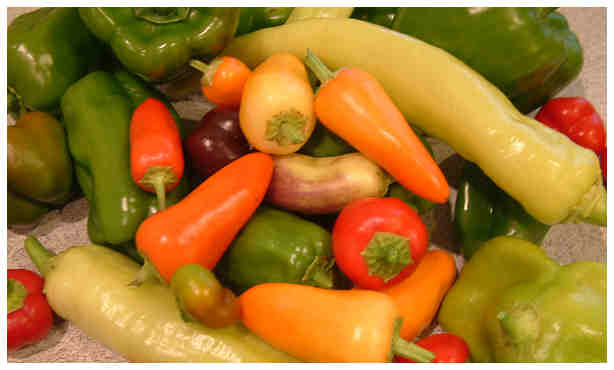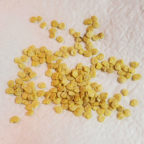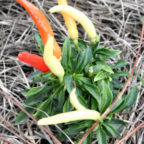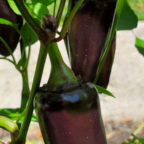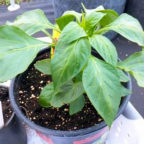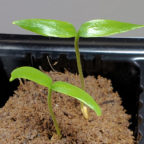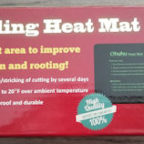Pepper Insects
Pepper insects are usually more of a problem than pepper diseases themselves. Your best defense is to inspect your plants often  and control the disturbance before it plagues you (couldn’t resist the pun). Seriously, insects can ravish your pepper plants and fruits, destroying in a matter of hours your hard work. Don’t let the insects get the upper hand!
Pepper Insects
The most common insects and their suggested means of control are listed below. I’ve listed organic means of controlling these insects because I think we get too much in the way of chemicals in our bodies from other sources; we don’t need it from our garden. However, there are environment-friendly insecticides out there on the market, like Oil-Away Supreme Insecticidal Spray.
Aphids: These are very small insects, coming in various sizes (1/16 to 1/8 inch in length) and colors (brown, yellow, pink, or black). They harm pepper plants by piercing the stems and sucking the juices out of the plant. Aphids also secrete a sugary fluid known as honey-dew, which gums up the plant and serves as a medium for the growth of sooty fungus.
Preferred method of control is to spray the plant with warm, slightly soapy water (make sure to get the underside of the leaves, too!) The backup control is to dust the plants with diatomaceous earth. Repeat the treatment in a week. And a third time as well if the second application didn’t get all of them.
Thrips:Â Thrips are small (about 1/16 inch long) and slender insects. They live in flowers, on tender leaves and leaflets, feeding on the sap. One part of the thrips’ mouth acts like a rasp and tears the surface of the plant, exposing the contents. The fluid is then sucked up through another part of the mouth. The adults range in color from yellow to black, while the immature wingless nymphs are light in color. Their feeding usually causes leaf-curl (leaves curl in an upward fashion) or some type of distortion.
Preferred method of control: spray them with warm, slight soapy water. When dry dust the plants with diatomaceous earth.
Spider Mites:Â Spider mites are about 1/60 of an inch long, and they may be whitish, green or red, depending upon the species. They are eight-legged (the insects have six legs) and are close relatives to spiders rather than insects. Spider mites live on the sap of the plant which is drawn by piercing the leaf with two sharp, slender lances attached to the mouth.
Mites spin webs as do spiders, and are able to be blown from field to field by floating or parachuting in the wind. In periods of hot dry weather the leaves of host plants become blotched with pale yellow, reddish-brown spots ranging from small to large areas on both upper and lower leaf surfaces.
The leaves become pale and sickly in appearance, gradually die, and drop off the plant (the leaves look as though they have been dusted with some sort of powder, caused by molted skins of the mites). The mites are also pests of plants grown inside or in greenhouses.
The preferred method of control is hosing off with cold water, followed by a thorough dusting of diatomaceous earth. A second treatment must be applied from five to seven days following the first, in order to control spider mites. This is because the first application kills the nymphs and adults, but the eggs might still hatch, giving birth to a new generation.
Various Caterpillars:Â These critters are able to munch a pepper plant in no time, if left unchecked. Preferred method of control is to pluck them off and drown them in soapy water.
Cutworm:Â These worms are able to “mow down” young seedlings, by munching clear through the stem! The preferred method of control is to place a “collar” around the pepper plant. This can be as simple as taking the tissue roll (or a paper towel roll, cut in half) and carefully placing it over the pepper plant and pushing it an inch or so into the spoil. Tin foil also works.
Leafhoppers:Â Leafhoppers vary in size from 1/20 to 1/4 inch but a few will reach 1/2 inch in length. Most are wedge-shaped, broad at the head and pointed behind. They are often brilliantly colored, and may have solid, striped, spotted or banded color patterns. However, some are dull colored (brown, tan, gray). When leafhoppers are abundant on any crop, the plants show a lack of vigor, growth is retarded and, in most cases, the leaves have a mottled appearance, or turn yellow, red or brown. This is due to the leafhoppers sucking out the sap. Several species of leafhoppers transmit plant viruses. The adults lay eggs in the plant stem, buds or leaves, which hatch into wingless nymphs (which feed the same way as the adults). Control is usually accomplished by proper spraying of the crop with a recommended insecticide Safer brand preferred).
Whiteflies:Â This insect is about 1/32″ long, and is light in color. It inhabits and feeds on the undersurfaces of leaves by penetrating the tissue and removing plant sap with its piercing-sucking mouthparts. Adults congregate, feed, and mate on the undersurfaces of the leaves, and this can occur in such numbers that “clouds” of insects appear, when disturbed. Other forms of damage include the removal of plant sap, vine, leaf, and plant breakdown, yellowing, leaf shedding and abnormalities of fruiting structure. Control is difficult, but try warm soapy water.
Nematodes:Â This tiny worm ends up being a systemic problem, so I’ve included the full write-up in the pepper diseases post.
Pepper Diseases
There aren’t a ton of pepper diseases that will plague you, which is fortunate. However, the two main diseases can pretty much decimate your plants if not controlled.
Pepper Diseases
Let’s take a quick look at the two most common ailments that can effect your pepper plants (bell, sweet and hot), and how best to avoid them.
Nematodes:Â Plants are dwarfed, sickly, and will sometimes wilt readily in dry weather. Roots showing swelling or galls, and can let in bacteria. This is actually caused by a tiny worm, and if you get rid of the nematodes, you will remove the problem.Â
These tiny worms infiltrate the root system, crippling and even killing the plant. Since nematodes are most prevalent in sandy soil (common in the southeastern US), you’ll need to take extra care if you live in this area.Â
If you find your plants are plagued by a nematode infestation, you have three options:
- Move your garden to a different site in your yard, which may or may not be nematode-free.
- Solarize the soil (see below) then plant marigolds (which nematoes dislike intensely).
- Create raised beds for your garden, raised by at least 6 inches. You’ll need to dig out an area at least a foot deep and at least two feed wide. Then you’ll need to fill it back in with compost, composted manure, sphagnum moss, etc. Do not use any of the soil you dug out to re-fill the trenches.
- Plant your peppers in containers. Since pepper plants tend to remain under 3 feet tall (one notable exception being jalepenos), they are pretty well-suited for container growing. In fact, since I live in a nematode area, I grow all my peppers in containers.
Solarizing:Â Â To solarize the soil, till the ground, then cover it with a thick, clear plastic. The sun will “bake” the soil, killing the nematodes. Since you also kill all the “good” bacteria by this method, so be sure to spread some compost over the solarized soil a week or two before planting.
(Although nematodes are technically an insect, since their effect is systemic, I’ve included them in the diseases section.)
Tobacco Mosaic Virus: Green or yellow mottling of leaves; some curling, malformation, and dwarfing of leaflets. Plants slightly stunted. Fruits mottled by yellow strains of the virus. Can be passed from plant to plant by handling wet plants that are infected, then handling healthy plants (for example, when examining fruits on a damp morning.) This disease is widespread throughout the USA.
It’s thought that handling tobacco can transfer the virus to pepper plants. Some people say no, some say definitely. At any rate, if you do smoke or otherwise handle tobacco, it would be wise to wash your hands thoroughly before working with your peppers.
Other Notes on Pepper Diseases
Like their (far-flung) relatives the tomatoes, peppers can fall prey to bacterial infections. Fortunately, most peppers (in my experience) have been less-susceptible than tomatoes. Still, you want to make sure you have plenty of air circulation around the pepper plants, and that you don’t water the foliage (except with a foliar spray early in the morning before the dew has dried).
Germinating Pepper Seeds
Germinating pepper seeds can be a wee bit frustrating at first, mainly because it takes so long for the seeds to germinate. But once you have done it a few times, it’s pretty easy.
Why should you try germinating pepper seeds, instead of just buying plants at your local garden center? One reason is because the selection at your garden center is very likely limited. At best you’ll find 10 pepper varieties, more often less than that.
Usually the gorgeous ornamental-appearing peppers don’t show up in the garden center; these have to be grown from seeds. Two wonderful varieties that come immediately to my mind are Explosive Ember and Sweet Pickle.
Pepper Germination Rates
First of all, don’t expect a 100% seed germination rate from your pepper seeds. While you just might get 100%, in my experience in growing many, many varieties, 75% is more the norm. So I plant 25% more seeds than I need, and if they all germinate and thrive, I can sell or give away the extras.
Germination rates vary according to how long ago the seeds were harvested, as well as how the seeds have been stored. Generally, you want to use pepper seeds within 2 years, but they can germinate long after that time, too.
For example, I have some 10-year-old seeds that I planted a week ago, and I fully expect that some will germinate. I just planted a lot extra, because I knew the germination rate was going to be low. However, some of these seeds are rare varieties, so they are worth trying.
I tend to buy my pepper seeds online, but I’ve been known to pick up a pack at the garden shop from time to time. Either way, you don’t know for sure how old those seeds are. Always plant extra.
Germinating Pepper Seeds – Warmth and Humidity
When germinating your pepper seeds, the two most important things are heat and humidity. Peppers like plenty of warmth, and germinate best at soil temperatures of 80 to 85 degrees.
While those seeds are sitting in the warm soil, they need to be kept damp, but not wet. They need the moisture to soften the seed coats, so the plants can be born (so to speak). I like to use a windowsill greenhouse when germinating pepper seeds; the top of the greenhouse keeps in the humidity. And a bonus is that these little mini-greenhouses are inexpensive, so you can have lots for many windowsills.
However, if you live in a cooler climate, you may want to use a heat mat under your peppers to be germinated.  Please don’t use a household heating pad; that could be dangerous. Instead, get one that’s waterproof and made for keeping seeds and seedlings warm.
If you are planting pepper seeds directly outside, wait until the soil temperature has reached at least 65 degrees and that they get full sun, to heat the soil even more. Remember to keep the soil damp, but not wet.
That’s it for now! If you want to read more about seed starting for peppers, read my posts on seed starting part 1 and seed starting part 2. Enjoy!
